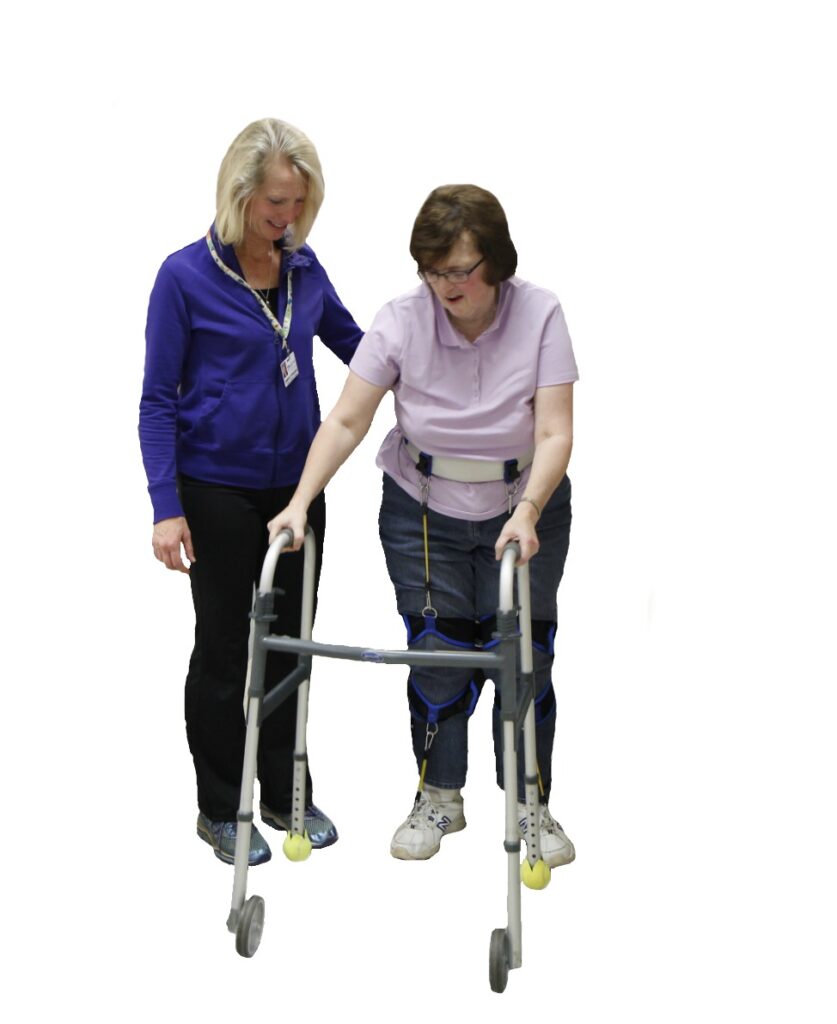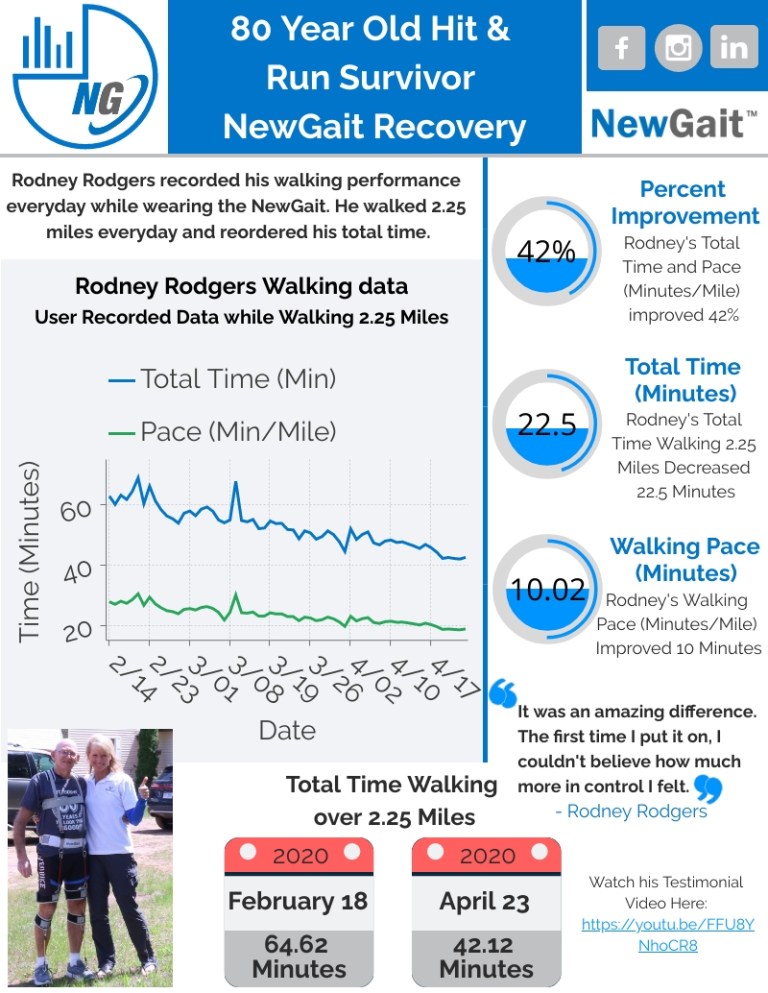


Despite significant advancements in post-stroke medical treatments and rehabilitation interventions, more than half of stroke survivors cannot walk independently in the community. Current rehabilitation devices aimed at restoring walking function are either large and unaffordable or ineffective in improving walking function, creat-ing a significant unmet need for a portable, affordable, and effective gait mobility/rehabilitation device. In this Phase-I STTR, Elite Athlete Products will incorporate stroke-specific modifications to the current NewGait de-vice based on end-users’ feedback and biomechanical simulations and rigorously test this device against com-petitors’ products to make evidence-based gait training strategies accessible to all stroke survivors.
University of Michigan
Dr. Chandramouli Krishnan
Dr. Edward S. Claflin
Dr. Claire Kalpakjian
Dr. Alyssa Portelli, DPT
Wayne State University
Dr. Edward P. Washabaugh
For more information click here.
Abstract
The purpose of this quasiexperimental study was to test the effects of wearing the NewGait rehabilitative device on walking abilities in individuals with foot drop. The study involved 16 participants with foot drops caused by stroke (11 participants), multiple sclerosis (one participant), and peripheral neuropathies (four individuals). During a single testing session, participants walked 12 m at their self-selected speed in four experimental conditions: walking without any orthotic device; walking while wearing a regular plastic posterior leaf ankle foot orthosis (AFO); walking with the NewGait device assisting ankle dorsiflexion only; and walking with the NewGait device assisting the hip, knee, and ankle joint motions. Body motions during walking were recorded using a 3D system for motion analysis and analyzed with a set of spatiotemporal and kinematic parameters and a gait decomposition index. The gait decomposition index indicated sagittal interjoint coordination in the three joint pairs (hip–knee, knee–ankle, and hip–ankle) of the paretic (foot drop) leg during walking and was validated in a previous study. Overall, wearing all three orthotic devices improved the gait velocity, ankle dorsiflexion, and foot clearance compared to gait trials in which no assistive devices were used. However, wearing the AFO significantly restricted the plantarflexion range of motion and decreased interjoint coordination as measured by joint decomposition. In contrast, the NewGait device altered the ankle plantarflexion motions but also increased coordinated movement (reduced the decomposition) in most lower-extremity joint pairs and conditions. Therefore, the NewGait rehabilitative device can be considered superior to a regular AFO in correcting gait deviations caused by foot drop.
Authors: Ksenia I Ustinova, Joseph E Langenderfer
Abstract
Purpose: Impaired gait is one of the earliest, most devastating, and long-lasting symptoms associated with neurological disorders. This study tested the feasibility of wearing the NewGait rehabilitative device in individuals with gait impairments due to the most common neurological disorders.
Methods: Seven participants with gait impairments due to strokes, Multiple Sclerosis, peripheral neuropathies, Cerebral Palsy (CP) and Parkinson’s Disease (PD) were included in the study. Their walking with and without wearing the NewGait was analyzed and compared using the Vicon T160 system for motion analysis. Gait velocity, step length, foot clearance, lateral displacement of the Center of Mass, gait deviation and symmetry indexes were compared using two standard deviation band method for each participant.
Results: Participants subjectively assessed the NewGait as a comfortable device to wear and showed immediate gait improvements to varying degrees. Most improvements were observed in participants with muscle weakness due to peripheral neuropathies, stroke, MS, and CP. These participants improved their foot clearance, gait velocity, and step length. Participants with cerebellar stroke and PD increased their gait stability. All participants demonstrated a reduction in composite gait deviation indexes. Not all gait parameters, though, showed immediate changes.
Conclusion: The results suggest that the NewGait rehabilitative device is feasible and useful for correcting gait impairments caused by neurological deficits. Participants may need to wear this device for longer periods of time in order to achieve long lasting changes in the gait pattern, rather than an immediate correction.
More info: https://pubmed.ncbi.nlm.nih.gov/37818770/
Authors: Kathleen M. Tooman, PT, Jozie Weiler, PT, DPT, Cathy A. Larson, PT, PhD
Abstract
BACKGROUND: Joint replacements following years of osteoarthritis create disruptions in functional activities that are challenging to modify. The purpose of this case report was to describe the use and efficacy of the NewGait™, a device that is designed to facilitate, stabilize, and inhibit muscles used during functional activities such as walking and sit to stand, for a person with bilateral hip and knee replacements.
CASE PRESENTATION: This 69-year-old male participant had previously received physical therapy interventions after multiple surgeries. Residual impairments and functional deficits remained 5 years postoperatively including slow, unsteady gait and functional activity limitations. NewGait™ was used as a sole treatment for 10 sessions.
OUTCOMES: Goals to improve safety and speed in sit to stand and gait, as well as the ability to get in/out of cars and on/off a bike, were achieved.
DISCUSSION: Further exploration as to the efficacy of the NewGait™ to alter gait and function is warranted. JOSPT Cases 2023;3(1):43–52. Epub: 4 November 2022. doi:10.2519/josptcases.2022.11282
More info – https://www.jospt.org/doi/full/10.2519/josptcases.2022.11282
Abstract
Background/Purpose: Running is a complex skill requiring synchronization of neural centers, joints, and muscles. The athlete in this study presented with poor dynamic ankle function, running mechanics, and chronic pain. Physical therapy interventions had been successful but not sustainable since the age of 10. The purpose of this case report was to determine if the use of NewGait could improve running mechanics in a high school athlete.
Methods: NewGaitTM was used for 8 visits. Standardized tests and 2D videos were done on first and last visits.
Clinical Findings: The athlete had no complaints of pain by last visit. All standardized test scores showed improvement, and 2D videos demonstrated significant changes in ankle and running mechanics. Improvements were sustained at one year follow-up appointment.
Conclusion: NewGait was successful in altering running and jump mechanics.
Clinical Relevance: NewGait may be a reasonably priced, easy to use clinical tool to alter ankle and running mechanics.
More information – https://www.orthopt.org/uploads/OP_October_web_based_FINAL.pdf
While the NewGait is an innovative device aimed at making therapy easier and more effective for clinicians and improving patient quality of life, it’s mechanistic principals are not new. Elastic band training has been in use for decades and dozens if not hundreds of research studies point to it’s effectiveness. The NewGait has enabled an easier and more effective application of that technology. Below are just a few studies attesting to the effectiveness of elastic resistance training.
The purpose of this case report was to describe how the NewGait was used during spinal cord rehab to help an incomplete paraplegic become a functional ambulator
The purpose of this case report was to describe how the NewGait was used during spinal cord rehab to help an incomplete paraplegic become a functional ambulator
Within three treatment sessions, patient was able to start walking on the treadmill both forward and backward without upper extremity support while wearing the NewGait.
One month after the NewGait was initiated, the patient started running while wearing it. This was a huge milestone as she was told she would never run again. Three weeks later, she ran a 12-minute mile.
“The NewGait may have provided enhanced, simultaneous feedback to mechanoreceptors and proprioceptors of the core and limb, initiating change in neuro motor sequencing and development of new motor plans.”
"The NewGait upper body harness appeared to assist with erect posture and support, while discouraging previous upper body motor control patterns. This may have encouraged the lower body motor plans to dominate walking, running and jumping."
“The patient had profound, lasting results in ankle and hip motion control, and the patient’s running style was dramatically changed. She was able to functionally activate the gastrocnemius for jumping and heel/toe gait pattern during push off."
The purpose of this case report was to describe how the NewGait was used during spinal cord rehab to help an incomplete paraplegic become a functional ambulator

Participants increased their walking speed enough to characterize them as independent in activities of daily living.”
All 12 participants became more symmetrical in their gait, as specified by step length.”
Participants were able to walk faster with less effort.”
See the Full Case Study Result Here
After being hit by a hit-and run-driver, Rodney had to learn how to walk again. He was introduced to the NewGait after a lengthy recovery. Rodney recorded the time it took him to walk 2.25 miles every morning for two months while wearing the NewGait. See the incredible improvements and his story below.`1q
